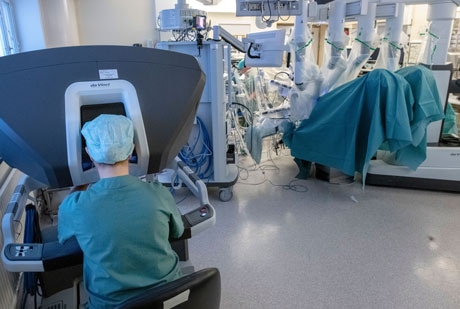Apr 10 2019
A boy measuring 48 cm in length and 2900 g in weight is the first baby born after the technological transformation in Gothenburg’s world-leading research on uterine transplantation. The birth was a planned cesarean delivery on April 8th. The whole family is doing well.
 Robot-assisted keyhole surgery used for uterine transplantation, operation on a donor November 2018, plus portrait pictures of members of the team (photo: Björn Larsson Rosvall)
Robot-assisted keyhole surgery used for uterine transplantation, operation on a donor November 2018, plus portrait pictures of members of the team (photo: Björn Larsson Rosvall)
It’s a fantastic feeling to deliver such a special, longed-for child. To have been part of the whole process, from the first meeting with the couple to the uterus transplant, and now to see everyone’s joy when what we’ve hoped for becomes reality. It’s simply wonderful.
Pernilla Dahm-Kähler, robot-assisted surgeon and gynecologist and research scientist, Sahlgrenska Academy, University of Gothenburg.
This baby was born within the scope of this research project. The baby was delivered into the world after a uterine transplantation wherein the donor, the recipient’s mother, was operated on with robot-assisted keyhole surgery. This technique is significantly less invasive for the donor than traditional open surgery.
Mats Brännström, Professor of Obstetrics and Gynecology at Sahlgrenska Academy, heads the research efforts.
“This is an extremely important step towards developing the surgery involved in uterine transplantation, and its safety. For the first time, we’re showing that the less invasive robot-assisted surgical technique is practicable.”
One-centimeter incisions were done on the abdomen of the donor. The robotic arms holding the surgical tools were assisted by two surgeons, one on either side of the patient. Each surgeon sits at a personal workspace a few meters away, with a joystick-like tool and enlarged 3D screen image that enables robust precision for operating deep within the lower abdomen.
More robot assistance in the future
At the final phase of the procedure, another incision was made so that the uterus can be taken out. It was then straightaway implanted in the recipient by means of open surgery. The new method makes a huge difference for the donors, who mostly feel better afterward and get back to normal sooner.
Niclas Kvarnström is the transplant surgeon in charge of the project, and the person who carried out the complex task of connecting vessels in the uterus recipient.
“In the future, we’re also going to be able to transplant the uterus in the recipient using robot-assisted keyhole technique.”
In the present case, the transplantation was performed at Sahlgrenska University Hospital in October 2017. Ten months later an embryo, which had developed through in vitro fertilization before the transplantation, was implanted in the transplanted uterus, and a few weeks later the doctors were able to determine pregnancy upon hearing a distinct heartbeat. The pregnancy has been free from problems, with the mother in good health during the course of the medical procedure; now, it has, therefore, ended with a planned C-section at 36 weeks pregnant.
Eight plus one
The child currently born is the number nine in Sweden following a uterus transplant and number one in what the scientists refer to as “the Robot Project”— wherein more pregnancies and babies are anticipated in the coming years. Six transplantations were performed between 2017 and 2018, and the team is also carried out the first uterine transplant using an organ from a dead donor.
So far, a total of 15 babies globally have been born from a transplanted uterus. In addition to the nine born within the scope of this Sahlgrenska Academy research, there are two in the United States and one in each of Serbia, Brazil, India, and China.
Mats Brännström highlights the great significance of the method, developed over a period of 15 years’ research at Sahlgrenska Academy, currently also functioning in other parts of the world — in a number of cases following direct technology transfer from the team at Sahlgrenska.